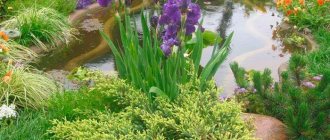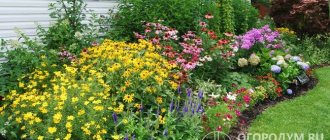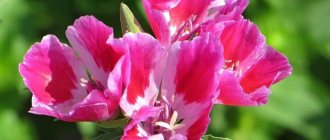Photo: pinterest.at Small and bright, long-lived asters that can be found in gardens and on balconies are ageratum. Compact fluffy bushes do not leave gardeners around the world indifferent. Their beauty is very modest, but also very elegant at the same time! And now we will tell you what types of ageratum exist and how to care for them!
Botanical description of the plant
Ageratum (photos of flowers in a flowerbed are distinguished by their extraordinary brightness and beauty) belongs to the Astrov family; it received its name from the Greek “ageless” for its abundant and long-lasting flowering, as well as the long-term preservation of its attractive decorative appearance when cut.
The plant is a perennial herbaceous shrub with branched, numerous erect stems that have slight pubescence. The shoots are covered with triangular, oval or diamond-shaped leaves with jagged edges and a rough surface. The lower leaves are located opposite, attached to the stems by petioles, and the top shoots are covered with sessile alternate leaves.
The height of different varieties of ageratum ranges from 10-15 to 50-60 cm.
Small, fragrant, narrowly tubular flowers are collected in baskets, 1 to 2 cm in diameter, which form larger complex corymbose inflorescences. Long and abundant flowering continues from the beginning of June until frost.
Flower colors can be of different saturations:
- white;
- blue;
- pink;
- lilac
- purple color.
After flowering, the plant forms very small 5-sided seed-bearing fruits, which ripen by early autumn and remain viable for at least 3-4 years.
The natural habitat of this perennial herbaceous plant in the wild is Central and North America, as well as the eastern part of India.
And from there this decorative species was brought in the 19th century to Europe, where breeders had already bred about 60 different varieties, among which the following are the most popular:
| Name | Description | Peculiarities |
| Houston | The heart-shaped leaf plates are almost devoid of teeth along the edges and have slight pubescence. The low-growing bush reaches a height of about 20 cm. The flowers are white, purple, blue or pink. | The plant has analgesic, anti-inflammatory and analgesic properties. |
| North Sea | The shortest variety, does not exceed 15 cm, blooms with deep purple saturated flowers. | Abundant long-term flowering is used to create mixborders. |
| Blaue Kappe | A low-growing spherical variety with erect shoots 20-25 cm long, has loose inflorescences and dark green foliage. | A late variety, abundant flowering can last until the beginning of October, at almost 0 degrees. |
| Alba | The spherical compact bushes reach no higher than 20-30 cm in height and are distinguished by white, blue or lilac fluffy flowers. | Terry late-blooming variety blooms no earlier than June 20, suitable for creating borders. |
| Blue ball | Low-growing herbaceous spherical subshrubs up to 17-20 cm tall, with thick, highly pubescent shoots and large fleecy foliage. The inflorescences are large, the basket reaches 2 cm in diameter. The color can be blue or dark lilac. | Late-flowering variety, abundant flowering begins at the end of June, very unpretentious to soil moisture. |
| White ball | The plant does not exceed 25 cm in height, has long creeping shoots and fluffy snow-white inflorescences up to 15 mm in diameter. | Looks advantageous in group plantings and flower arrangements with other varieties. |
| Blue Mink | A bush up to 30 cm high, with thick shoots and a small number of leaves and very large inflorescences with a diameter of more than 2 cm. | The unusual variety is distinguished by the columnar shape of the bush. |
| Blue bouquet | Medium-sized shrub up to 45-50 cm, with bright lush blue flowers. | The stems of the plant can be either erect or lodging. |
| Pink fire | Compact, low-growing variety up to 30 cm, with small leaves and large bright pink inflorescences. | Suitable for dense mass compositions, for growing in pots on terraces and patios. |
| Summer Snow | A medium-sized subshrub up to 50 cm tall with large, large, lush and dense white inflorescences. | Characterized by abundant flowering. |
| Red Sea | An unusual hybrid variety with a powerful vertical stem reaching up to 60 cm in height. Blooming red shaggy flowers. | It blooms all summer until the first frost. |
| Blue Perfection | A very compact, highly branched, spherical subshrub about 30 cm tall, with strong, highly pubescent shoots and large leaves on long petioles. Inflorescences from 14 to 16 mm of lilac or blue color. | The stems are an unusual purple hue. Flowering is early, in early June. |
general information
Ageratum came to us in the nineteenth century from America and East India. Its name translates as “ageless,” and this is true, because throughout the year the appearance of the bush remains almost unchanged. When cut, the flowers remain fresh, attractive and fragrant for a long time.
The shape of the leaves depends on the variety - oval, triangular and diamond-shaped, but they are always small and jagged. The longest and largest species stretch up to 60 cm, and the smallest - up to 10. Small flowers of all shades of blue and purple are collected in dense elastic inflorescences. Each individual flower resembles a basket with a diameter of up to one and a half centimeters.
Photo: oir.mobi
Conditions for keeping the plant in the flowerbed
Ageratum (photos of flowers in a flower bed can be seen in various landscape design compositions) requires certain conditions for active growth and abundant flowering.
Lighting
All varieties require bright sunlight for long periods of the day.
Even shading for more than 2 hours will significantly reduce the decorative value of the flower, since the stems will begin to stretch, the leaves will begin to grow sparsely, and the inflorescences will decrease in number and size. In open sunny areas, the flower feels good even in the intense summer heat.
Temperature
This heat-resistant, light-loving plant tolerates any increase in temperature well, but with a slight cold snap it can die, so it is necessary to additionally cover the shrub in case of any danger of frost, and before the onset of autumn cold, you can dig up the flower and transplant it into a container, putting it away indoors or in a greenhouse overnight.
Humidity
Most varieties do not tolerate severe drought or stagnation of moisture at the roots. Spraying the plant is contraindicated, since ageratum tolerates dry, hot air very well, provided there is sufficient regular watering.
Soil and drainage
The plant prefers to be grown in light, nutritious soils with a neutral or moderately alkaline reaction. You should not add a large amount of organic matter to the soil, as this will lead to an increase in green mass and a reduction in flowering.
Planting on heavy, wet soils will require the creation of a drainage layer and additional loosening so that oxygen reaches the roots, otherwise the flower will begin to hurt and may die.
Watering
It is necessary to provide the plant with regular, abundant watering after the top layer of soil has dried 1-2 cm. Heavy rainfall or spraying can have a bad effect on the decorative appearance of the flower, so it is necessary to water only in the morning or evening, exclusively at the root.
After watering, it is recommended to carry out additional loosening of the tree trunk circle for better air supply to the roots.
Step-by-step instructions for growing
Ageratum (a photo of flowers in a flowerbed makes you want to plant them in your own garden) is quite unpretentious to grow, so it is suitable even for novice gardeners.
- First you need to purchase high-quality seed material of the selected plant variety. You can buy ready-made seedlings at a store or garden nursery.
- Plants can be planted in a flowerbed in the form of seeds or young seedlings in the middle or end of May, only after the threat of frost has passed, otherwise the flowers will need to be additionally covered.
- When group planting low-growing varieties, it is necessary to maintain a distance of at least 10-15 cm, and when growing larger specimens, about 35 cm between bushes will be required.
- Next, you should water the plants well; you can mulch the tree trunk circles with bark or decorative wood chips, which will prevent the rapid evaporation of moisture and the growth of weeds.
Ageratum planting and care in open ground
Soil composition: Ageratum really doesn’t like acidic soil, if that’s what you have, it’s better to sprinkle it with lime in the fall, then it will become less acidic. The soil should be light, preferably drained, with good air permeability to the root system. Do not fertilize the soil too often and do not plant in very oily soil. This will lead to the fact that the vegetative system will develop strongly, and flowering will be weak.
Lighting : This plant variety is very light-loving and should be planted in well-lit areas. If Ageratum is planted in shaded areas, it will be underdeveloped, begin to stretch out, flowering will be reduced to a minimum, and of course the colors will be dull.
Watering: Do not water too often to avoid root rot. But this plant does not tolerate drought well. It is not advisable to water on the foliage. The correct thing to do would be to water abundantly at the roots, then not dry for too long, and loosen the soil around the stems.
How to plant seedlings in open ground
Hardening: A couple of weeks before transplanting outside, the seedlings need to be hardened, otherwise they will take a long time to grow and get sick, will be weak and more susceptible to various diseases. How hardening occurs: cups with pickled seedlings are placed in warm water and taken outside, first for 20 - 40 minutes, increasing the hardening time daily by 15 -20 minutes. Naturally hardened in the absence of frost.
Planting rules: picked seedlings of low-growing varieties are planted in holes at a distance of 10 -15 centimeters. Tall varieties are 25 - 40 centimeters apart. The seedlings should not be buried too deep; plant them in the hole at the same depth as in the pot. To avoid stagnation of water in the holes, it is better to fill them with drainage before planting.
These step-by-step photos will demonstrate when and how to properly plant Ageratum flower seedlings in open ground:
Care for Ageratum in open ground
- It is better to fertilize with mineral fertilizers rather than organic ones. Fertilize 3-5 times per season so as not to oversaturate the soil.
- To form a beautiful, branchy bush, be sure to pinch and trim it as it develops and grows. If the stem stretches too far, cut off the top.
- Regularly cut off faded buds so that they do not take away the strength of the plant and do not interfere with new inflorescences.
- It is advisable to loosen the soil after each heavy watering.
Plant propagation methods, instructions
There are 2 methods for growing a decorative flower yourself.
Seeds
The easiest way to grow ageratum of any chosen variety is from independently collected or purchased seeds, which can be planted directly into open ground or through seedlings:
- The prepared soil, cleared of weeds, must be mixed in advance with a small amount of fertilizer, thoroughly moistened, loosened and leveled.
- Next, you should evenly distribute the fine seed over the surface of the ground, without burying the seeds in the soil.
- The top must be carefully sprinkled with a thin layer of dry sifted earth or sand.
- For seed germination, a temperature of 17 to 22 degrees is required, so if necessary, you can cover the plantings with a transparent film, periodically opening and ventilating the seedlings.
- It is necessary to water the seedlings about 2-3 times a week, making sure that the water does not get on the tender sprouts.
- After the appearance of 2 true leaves, when grown by seedlings, you will need to pick into separate containers, and then grow the seedlings until they can be transplanted into open ground.
Cuttings
This method is used when propagating hybrid varieties that do not produce seeds. This method allows you to obtain a low bushy ageratum, which will be grown indoors in winter as an indoor flower.
For cuttings you need:
- In early April, cut off shoots about 12-15 cm long.
- Treat the cuts with root or heteroauxin for better root formation.
- Place the cuttings in a container with moist, disinfected, loose soil or river sand, cover the container with transparent film or glass, and place on a light windowsill.
- Rooting occurs at a temperature of about 20-22 degrees for 2-3 weeks. At this time, it is necessary to moisten the soil and regularly ventilate the cuttings.
Flower care
Well-groomed ageratum bushes
In order for the ageratum to make its owners happy with lush flowering, it should be carefully looked after. You need to pay attention to watering, fertilizing, pruning, loosening, and weeding.
Top dressing
In order for the flower to grow actively and bloom beautifully, you need to regularly add fertilizer to the soil. This is usually done once every 14-21 days. Here it is advisable to use humic and mineral fertilizers. You can take organic matter - mullein infusion.
Complex feeding
The use of fresh manure is strictly prohibited! This will lead to negative consequences.
Many gardeners prefer complex fertilizers. Initially, feed the flower with a minimum dosage. If there is an excess, the growth of ageratum slows down. Much does not mean good.
Watering
Watering should be done systematically. It is important to ensure that the plant is not over-watered. This will lead to rotting of the rhizome.
On hot days, one abundant morning irrigation is enough.
But in any case, you need to look at the circumstances. If there is no sun, then 3-4 times a week is enough.
Trimming
To get lush and beautiful bushes, you need to periodically prune the plant. During pruning, only a few internodes remain (3-4, no more). This promotes flower growth. It is also necessary to regularly remove those inflorescences that have wilted.
Secateurs are a must-have tool for a good gardener.
If there are damaged parts of the plant, it is advisable to remove them immediately. If the cause of their deterioration is a disease, then they are burned, and the plant is immediately treated with a special preparation.
Weeding
The gardener is constantly required to weed the beds to remove weeds.
If this is neglected, the weed will take all the useful substances from the soil, and accordingly the flowers will lack them. Pests are also much more likely to appear in the grass. All this will not only slow down the growth of the plant and lead to poor flowering, but can also contribute to its death.
It is important to systematically loosen the soil. This will allow oxygen to penetrate to the root, preventing the formation of an earthen crust and various diseases.
After loosening, it will be useful to cover the soil with mulch. This will prevent rapid evaporation of moisture.
Here it can be used:
- straw;
- sawdust;
- dry leaves;
- compost;
- husk, etc.
If you listen to all the recommendations, the ageratum will bloom for a long time and actively.
What actions to take after the ageratum has faded?
Before the onset of the first cold weather, it is recommended to dig up the largest bushes and place them in separate containers. This beauty can be brought into the apartment, onto the balcony, etc.
Active flowering phase
After this, ageratum is grown as a houseplant. With the arrival of spring, the flowers can be planted in their original place.
The plant is not frost-resistant and will not survive even slight frosts. Leaving it in the ground for the winter, you can forget about it next year.
Is it necessary to replant the plant?
There is no need to replant a plant grown in a flowerbed as an annual. It is only necessary to plant the seedlings at the beginning of summer from a container or pot to a permanent place, after which it is good to water and mulch the tree trunk circle. This procedure, carried out by the transshipment method, is tolerated by the plant very easily.
If you want to preserve the variety, in the fall you can carefully dig up the roots with a lump of earth, place them in a suitable sized pot or container with a drainage hole and a layer of expanded clay at the bottom. Such a plant should be grown as an indoor flower, providing it with additional light during the winter period, and in May the plant can be returned to the flowerbed.
Is it necessary to prune the plant?
To maintain high decorativeness, ageratum requires regular sanitary pruning and removal of faded inflorescences, which also stimulates the formation of new flower stalks, as well as maintaining the compact and neat shape of the plant.
When pruning shoots, it is recommended to keep no more than 3-4 internodes, remove all dried and damaged leaves, and also conduct a thorough inspection for the presence of other damage and diseases, which, if detected, must be immediately cut off to a healthy part, and, if necessary, preventive treatment with special preparations.
Trimming or pinching the apical bud of the stem leads to the development of more side shoots, which is used by gardeners to form a more lush, branched crown of the plant.
History of selection
The plant is a compact bush with carved leaves of an interesting shape. The flowers have the main decorative value of the plant. They are small, collected in baskets.
Their fluffy structure touches you and their fragrant aroma enchants you. The flowers can be colored white, pink, or red, but more often there are variations with shades of corollas in blue-violet shades.
Ageratum Photos
Why does the plant dry out and turn yellow?
The causes of yellowing and drying of shoots may lie in insufficient soil moisture, as well as in a bacterial disease that begins in the upper parts of the plant. Necrosis affects the vascular system of the flower, blocking the flow of moisture into the cells of the leaves and the tops of the stems.
The affected areas should be immediately cut off and burned so that the disease does not spread to neighboring flowers, which are recommended to be spilled with a copper-containing solution.
As a preventative measure, it is necessary to thoroughly disinfect the tools used for pruning so as not to introduce pathogenic bacteria. You can also spill the soil with boiling water, a weak solution of manganese, or any fungicide before planting seedlings.
Pruning, processing, collecting seeds
The description of care must contain information about the need for periodic care of the bushes. Wilted flowers must be cut off. This will allow the plant to bloom more abundantly and beautifully.
It is advisable to prune heavily overgrown bushes. To do this, remove the bulk of the greenery. Only a few internodes are left on the stem. This will allow the plant to grow better and bloom more luxuriantly.
If it is necessary to obtain ageratum seeds, then wait until the fruit is formed. This is a long achene that contains up to 7 thousand grains. Each seed remains viable for up to 3–4 years.
Pest and disease control
This beautifully flowering plant is often attacked by pests and various diseases:
- When the soil is waterlogged, rapid fungal infection by root rot , which leads to withering of leaves and shoots, softening of the roots, and subsequently to the death of the plant. As a preventative measure, it is necessary to plant plants in light, well-drained soil. Water the flower at the root, and only after the top layer of soil has dried.
- Gray mold spores are carried by the wind or upon contact from a plant infected with the fungus, but they are activated at a certain increased level of humidity, appearing in the form of dark spots and a light coating. If detected, it is necessary to treat the soil and all neighboring plantings with a fungicide solution as quickly as possible.
- The root-knot or leaf nematode attacks the roots or tender young shoots of the plant, leading to rapid wilting, yellowing, deformation and cracking of the stems. First, the leaves turn yellow and then become brown or black. The roots of the plant become unnaturally thick. As a preventative measure, it is necessary to thoroughly disinfect the soil before planting seedlings or seeds, and carefully treat the tools. When the disease begins, the specimen must be immediately destroyed to prevent the disease from spreading to other plants.
- Viral infection with cucumber mosaic cannot be treated. When the first symptoms appear in the form of white or yellow spots, the bush should be dug up and burned, and the ground should be treated with bleach.
- Aphids infect young shoots and leaves of the plant, sucking out all the juices from it. To combat the pest and as a preventive measure, you can use spraying with a 5-day infusion of garlic or onion peels.
- The winter cutworm can cause damage by depositing larvae in the soil at the roots, after which the plant begins to wither and weaken. If there is a butterfly invasion, you can set traps with kvass or yeast water. Layed caterpillars will have to be collected and destroyed manually by placing them in a soapy solution. Using coffee grounds on the surface of the soil can also help as a preventative measure. In advanced cases, you can treat the plant with pesticides.
- Whitefly is manifested by the appearance of yellow spots on the leaves, which then become deformed, discolored and fall off, which leads to disruption of the plant’s nutrition. At the first manifestations, the affected parts should be cut off and destroyed, and the healthy plant should be treated with insecticides.
- Spider mites manifest themselves in the form of small yellow spots on the leaves, which subsequently dry out and become covered with a thin web. The affected areas can be treated with a strong solution of laundry or green soap, as well as alcohol. The procedure will need to be repeated after 7 days.
Fertilizers for plants
Ageratum (photos of flowers in a flower bed are distinguished by a large number of inflorescences) for abundant and long-lasting flowering requires regular feeding, which must be carried out in well-watered soil at intervals of 2-3 weeks.
Mineral mixtures
It is necessary to carry out regular fertilizing with special complex mixtures for flowering plants, adding them in minimal doses. It is advisable to choose mineral mixtures with a low nitrogen content, in which phosphorus and potassium predominate.
You should not feed the flower, as an excess of nutrients can lead to the opposite effect: to the growth of a large number of succulent leaves and shoots.
Organic fertilizers
It is good to use humic mixtures in moderation, as well as a diluted infusion of rotted cow or horse manure, but not fresh organic matter, which will burn all the roots and lead to the death of the plant.
Ageratum – photo
In nature, ageratum is an ageless perennial. Although this is impossible in our latitudes with frosty winters, you can contemplate such beauty from the first days of summer until the frosts!
Photo: na-dache.pro Photo: gardennews.ru
Photo: oir.mobi
Photo: artfile.ru
Photo: skachat-kartinki.ru
Photo: oir.mobi
Photo: prorastet.ru
Photo: alexsad.ru
Photo: flo.discus-club.ru
Photo: dachnaya-zhizn.ru
Photo: flowers.cveti-sadi.ru
Photo: kartoska.ru Photo: thespruce.com
Photo: gardennews.ru
Photo: 2110658.ru
Photo: oir.mobi
Photo: zen.yandex.ru
Photo: orchidea-shop.ru
Photo: krasivosti.pro
Photo: artfile.me
Photo: fonday.ru Photo: 56929053376655.moi-6-sotok.rf
Photo: 7dach.ru
Photo: tovary4you.ru
Photo: oir.mobi Photo: fotoload.ru
Hydrangea (80 photos): types and features of care
Possible difficulties in growing
When growing in seedlings, plants need preliminary gradual hardening, otherwise when planted in open ground, growth will stop or slow down, as well as leaf burn. It is recommended to remove seedlings in the morning and evening hours, gradually increasing the time spent outdoors.
With heavily thickened dense plantings, rotting of the above-ground parts of the plants may occur. It is necessary to ensure air flow and circulation to the shoots. When planting seeds directly into open ground in northern latitudes, flowering may be greatly delayed.
Use in landscape design, combination with other colors
Photos of beautiful and lush ageratum flowers in a flower bed illustrate various interesting options for using various plant varieties in garden landscape design.
Low-growing flowering shrubs are used to create decorative borders along garden paths or mixborders in flower beds and flower beds. Medium-sized varieties are suitable for creating color spots, decorating background plantings, making flower arrangements, and go well with zinnias, calendula and marigolds.
Use of ageratum in landscape design. Photo.
Tall ageratum is suitable for growing as a tapeworm in a flowerpot or for decorating large flower beds in combination with small-flowered daylily or phlox of different shades.
Reviews from flower growers
Lydia, 45 years old, Torzhok Every year I plant different ageratums on the balcony. Every year I worry about pests. But every year, absolutely healthy blue, pink and white flowers grow in the boxes. Looks like a little rug on each drawer.
Alena, 27 years old, Tver I’m a so-so florist, but suddenly a dacha appeared. The plot is not just small - in addition to the house and front garden, there is only a two-by-two-meter path to the house. Yielding to the persuasion of a neighbor, she bought ageratum seedlings. All summer there is a blue rug under the windows. By the way, the cat really liked it, she just sits next to him and smells the flowers. Marvelous.
Where to buy and cost of the plant
Seeds of various varieties of flowering plants can be purchased at various flower shops at prices ranging from 19-25 rubles. Garden centers and nurseries often offer seedlings for sale in the spring, which can be purchased immediately before planting in open ground. The cost of a seedling ranges from 30 to 100 rubles. depending on the variety.
Gorgeous photographs of options for using bright and lush Ageratum flowers in landscape design in a flower bed or in the garden will help you create your own options for designing garden paths or creating various spectacular compositions in an alpine hill or flower garden, choosing the right varieties according to their growth and combination of shades.
Types and varieties
Of the 40 or 60 species of the genus Ageratum, only one is widespread in culture - Houston's ageratum. Everything else sold in seed stores is its variety. There are many of them:
Blue Mink is the most common variety. It is considered the bluest of ageratums, but in reality it is not as blue as on the seed packets. It's more of a bluish-purple color.
There are other interesting varieties, but these are found on sale almost everywhere.
Varieties Pink Ball and Clown Nine Wine are rare, but are found in gardens. Ageratum Houston Ageratum Pink Ball Ageratum Cloud Nine Vine











